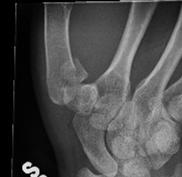We need you! Join our contributor community and become a WikEM editor through our open and transparent promotion process.
Thumb fracture
From WikEM
(Redirected from Bennet's fracture)
Contents
Background
Thumb fracture classification
- Type I (Bennett's fracture)
- Fracture-dislocation of the base of the metacarpal (intra-articular)
- Base fragment is aligned with trapezium, but distal portion is subluxed by abductor pollicis longus
- Most common type of thumb fracture; nearly always accompanied by some subluxation or dislocation of CMC
- Type II (Rolando's fracture)
- Comminuted version of a Bennett's fracture (intra-articular)
- Type III
- Extra-articular (transverse or oblique)
- Type IV
- Extra-articular pediatric fracture involving the proximal physis
Clinical Features
- Important to distinguish tenderness at base of 1st MC from injury to scaphoid, trapezium, or distal radius
- If pain or ecchymosis occurs more distally at the MCP (particularly on the ulnar side) consider ulnar collateral ligament injury (Gamekeeper's Thumb)
Differential Diagnosis
Hand and Finger Fractures
- Non-thumb metacarpal fractures
- Thumb fracture
- Finger (Phalanx) Fracture
Evaluation
- Imaging plain films
- AP, lateral, oblique
Management
- Splinting
- Type I, II - Thumb Spica Splint with the IP joint free and wrist in 30 deg of extension
- Type III - Short arm Thumb Spica Splint extending to the IP joint and wrist in 30 deg of extension
- RICE
- Significant swelling or overly aggressive icing to radial side of thumb may result in temporary palsy to the superficial radial nerve (numbness over the dorsum of the thumb)
- Reduction
- Indicated for angulated (more than 20-30 degrees), extraarticular fracture if clinician is comfortable with the procedure[1]
Disposition
- Refer within 3-5 days:
- All intraarticular fractures warrant referral (most require surgery)
- Extraarticular fractures that cannot be adequately reduced
See Also
References
- ↑ German C. Hand and wrist emergencies. In: Bond M, ed. Orthopedic Emergencies: Expert Management for the Emergency Physician. Cambridge: Cambridge University Press; October 31, 2013.

